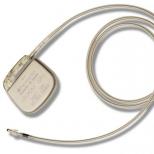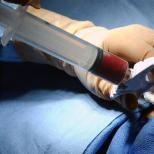Electrocardiogram of a healthy person
conduction system of the heart is designed to provide the function of automatism and conductivity, i.e. the ability to autonomously generate electrical impulses and distribute the excitation (depolarization) caused by them to all departments of the contractile myocardium. This system contains nodes and bundles (groups of specialized cells - pacemakers), in which electrical impulses and fibers are born, along which excitation moves, spreading to the contractile myocardium.
the greatest activity has a sino-auricular node (SA node). Under physiological conditions (at rest), it produces 60-80 impulses per minute. However, under certain situations, the pulse frequency can increase to 150-200. This is a first order pacemaker. The atrioventricular junction (AV junction), which includes the AV node and the initial part of the bundle of His, produces 40-60 electrical impulses per minute. This is a second order pacemaker. And finally, in the lower part of the bundle of His, only 25-40 impulses per minute are produced. This is a third order pacemaker.
It should be noted that automatism of the AV connection and the bundle of His is suppressed by the SA node and manifests itself only with lesions of this node. In the normal state of the SA node, the pacemakers of the second and third order perform only the function of conduction.
Speed conducting an electrical impulse in different parts of the conducting system is not the same. The minimum conduction velocity is observed in the AV node (50-200 mm/s). In the Purkinje fibers located directly in the myocardium of the ventricles, the speed of the electrical impulse reaches 4000 mm/s.
In this feature providential system has an important physiological meaning. Inhibition of conduction in the AV node and a high conduction velocity in the ventricular myocardium ensure rapid contraction of the ventricles only after the contraction (expulsion of blood) of the atria has ended. Inhibition of conduction in the AV node also contributes to the blocking of frequent impulses emanating from the SA node in its pathology.
Electrocardiogram of a healthy person
In a typical electrocardiogram usually there are several teeth located in different positions relative to the zero line (isoelectric line). Their location relative to the isoelectric line depends on the lead in which the electrocardiogram is recorded. In the standard, most augmented, and lateral chest (V5-V6) leads, the P, R, and T waves are positive, while the Q and S waves are negative. The isoelectric line (isoline) corresponds to the level of the T - P segment (from the end of the T wave to the beginning of the P wave) and is fixed on the ECG curve during the absence of a potential difference, which occurs during the "electric diastole".
Prong P is a reflection of atrial depolarization (excitation), the P-Q interval corresponds to the duration of atrioventricular conduction, and the QRST complex reflects the dynamics of depolarization in the ventricular myocardium. It is believed that the QRS complex reflects the spread of depolarization processes in the ventricular myocardium, and the RS-T segment and the T wave reflect their extinction. The Q wave reflects the processes of depolarization in the interventricular septum. Point J reflects the start of the S-T segment. By its deviation from the isoline, the magnitude of the displacement of the ST segment is usually judged.
Amplitude and the duration of the ECG waves and segments are normally shown in the figure.
When describing individual ECGs syndromes, we will dwell in more detail on the characteristics of these fragments of the electrocardiogram.
WHERE TO GO WITH MY DISEASE
Directory of VIDAL online pharmacies ISO KOVSKY LEK ARSTVA - quick and easy search for the desired drug in the database:
Enter the names of drugs in Russian, if the drug is not found - use English characters
If the name of the drug consists of several words, use only one for the search
Cardiogram of the heart of a healthy person
 The cardiogram of a healthy person shows the contractility of our heart. How to decipher a cardiogram? In this article, we will try to give you an accelerated study of the material. In general, cardiograms can characterize the heart rate, the functional state of the myocardium, and the state of the whole heart as a whole.
The cardiogram of a healthy person shows the contractility of our heart. How to decipher a cardiogram? In this article, we will try to give you an accelerated study of the material. In general, cardiograms can characterize the heart rate, the functional state of the myocardium, and the state of the whole heart as a whole.
How to understand that the cardiogram is without pathology?
The cardiogram of the heart of a healthy person is characterized by the following.
- In leads I, II, aVF, V2-V6, the P wave should always be positive. In lead aVR, on the contrary, it is always negative, like the T wave in the same lead.
- In leads V1-V4, the amplitude of the R wave increases. V5-V6 - decreases.
- In leads V1-V6, the S wave decreases until it is completely absent.
- The RS-T segment must be on the isoline. An error of 0.5mm is allowed.
These are not all normal ECG indicators. We suggest that you first look at the general scheme for decoding the ECG and then look at examples of various diseases, because without practice you can’t get anywhere.
The general scheme for decoding the ECG:

How do diseases look on cardiograms?

Conclusion on the first ECG:
- atrial flutter with rhythmic contraction of the ventricles 2:1.
- The voltage is reduced.
- Normal position of the axis of the heart.
- signs left ventricular hypertrophy .
 Conclusion on the second ECG:
Conclusion on the second ECG:
- sinus rhythm, incomplete atrioventricular block 2 degrees with periods of Samoilov-Wenckebach.
- The voltage is satisfactory.
- Deviation of the axis of the heart to the left.
- Cicatricial changes in the myocardium back wall.
Conclusion on the third ECG:
1. The rhythm is sinus. two-beam blockade of the left branches of the bundle of His. 2. The voltage is satisfactory. 3. Deviation of the axis of the heart to the left.





